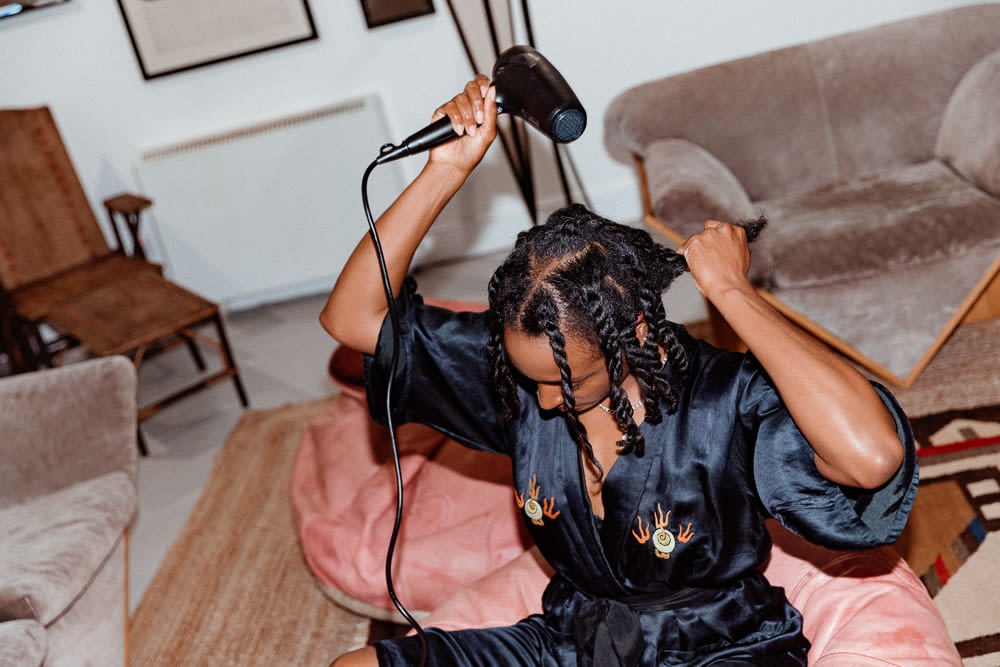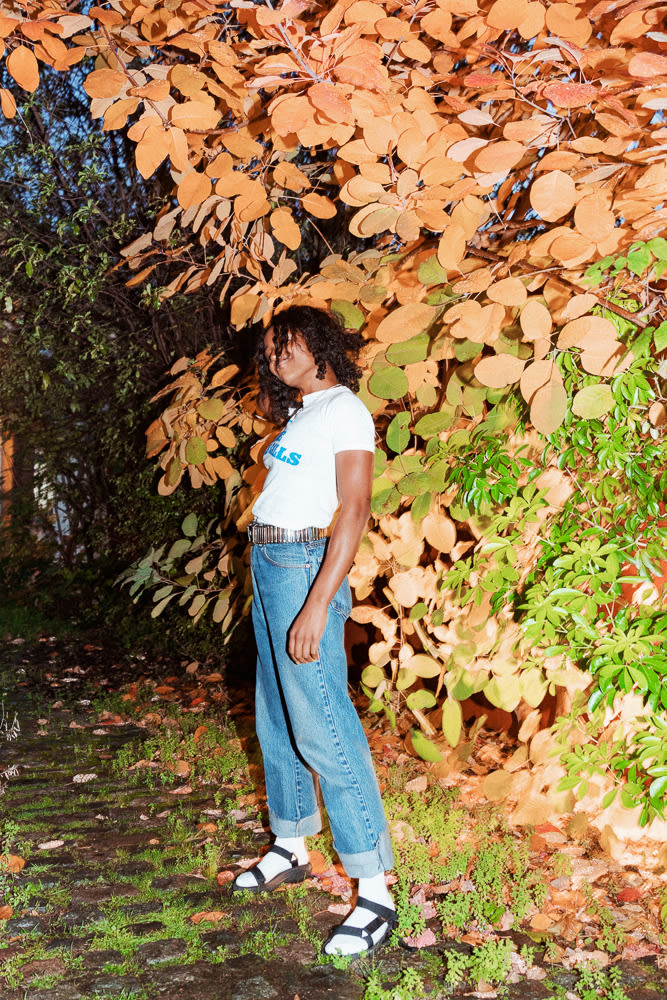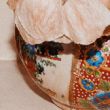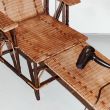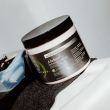Editor’s note: This isn’t your traditional The Top Shelf, and Cyndia Harvey isn’t your typical hairstylist. Trained under Sam McKnight and a tour de force all her own, Cyndia wanted to show you the process of getting her hair done: “You don’t really see a black woman getting presented in that kind of way, you know what I mean?” Part The Top Shelf, part The Professional, here’s more of Cyndia in her own words:
“Hairstyle culture is huge in Jamaica. In fact my mum was a hairstylist, and I used to go to her salon after school and watch her do hair. But I didn’t want to be a hairstylist then, I wanted more. So when I was 11 years old I got on a plane by myself and moved to England. I lived with my aunt for a year before my dad joined me. What was my big plan? [Laughs] I used to watch a lot of soap operas with my mum. I literally thought that’s what it was going to be as soon as I stepped foot out of Jamaica. Everything was promising, and hopeful, and rich. And everyone had everything.
CAREER
At 16, I still didn’t think being a hairstylist was a good enough job. I basically wanted to show off for the family I decided to separate from [in Jamaica]. I didn’t see at the time that hairdressing could be a way to do that for me, so I went to college and studied art instead. But after a year I decided that I was just going to do what I liked. So I enrolled and then flew through the [hairdressing] course.
My first few session work jobs [Ed. note: celebrity, photo shoot, and runway hairstyling is session work] were assisting hairstylists doing music videos, and then I used to do extensions for the Sugababes, once or twice. That was my little taste of it. It just goes to show you for someone like me, with my background, you have no way of accessing that kind of elite world—and it is an elite world. There was this magazine called Hairdresser’s Journal, and I was reading an interview from a sessionist stylist. One of the questions was like, ‘What advice you would give to young people wanting to get into the industry?’ And I literally followed the steps! [Laughs] It was like, know what hairstylists you like, find out what agencies represent them, contact those agencies and offer your book. And so I did that—I called everyone. Premier got back to me. They represented Sam [McKnight]. I got in touch with them unintentionally around the right time—fashion week was just about to begin, so they were looking for extra help. I assisted a couple of Premier artists, and they gave really good feedback about me. Within about six months I got to do a show with Sam. Then I got invited to do Chanel in Paris with him, and I was like, ‘Oh my god, what!’ It almost felt as if that was the peak of it all, at the time—which it was. It was a really big deal.
For any space a black woman enters, it’s almost like we’re being judged by that already. That’s why weaves are so popular. And it’s emotional, because you’ve never been made to feel proud of that, it’s always been a thing you have to change. You’re born with this hair that is not acceptable, and you spend your whole life trying to hide it. It becomes trauma! But being a black woman also meant I had a set of skills that was really valuable to the [Sam McKnight] team, and I really got noticed. They would ask me for more and more things, and when Sam’s assistant left, I became his first. I did that for four years. Sam couldn’t have been a more perfect person to work for—he’s super generous with his knowledge. Some people are a bit guarded about that, because they know that eventually you are going to go off. I’m so glad that he is the way he is, because I grew so much in those four years, personally and professionally. He really valued what I had to say, which gave me a huge amount of confidence. There were so many firsts—first time I went to New York, first time I went a lot of places. And then there’s no promotion—when you’re ready, you leave. Not before the moment I left did I ever feel like I wanted to leave, or was ready to leave. And then it was time—you just know.
HAIR HEALTH
I’ve always had thick, healthy hair. I had my first relaxer when I was leaving Jamaica. But of course, most people who have chemically relaxed hair—even hairstylists—don’t really understand what the hair has gone through to get there, therefore they have no true real understanding of how to manage and take care of it. So you just end up with this epidemic of black women whose hair can’t grow past a certain length, because it’s constantly breaking off. So I did that, and of course I too did not know what I was doing to my hair. My hair wasn’t ever troubled by it, but it certainly could’ve been way better.
I shaved it all off when I was 18, and I wore it like that when I was two years. It’s like a rebirth for a lot of women, you know? They’ve gone through years of relaxing, and then they decide to go natural. Sometimes it’s literally the only option, because it’s really hard to transition without cutting it off. So I buzzed it, and I used to color it quite a lot—blonde was my favorite. Then I wore a short, relaxed cut—I’ve made that transition at least three or four times in my life. Relaxed, natural, relaxed, natural. I just cut it off, and start from fresh each time. One of the times when I decided to do natural, I grew it out to quite a good length—I was always anti-weave. I don’t know why, I just didn’t like it. But then I decided to get a weave as I grew my hair out, and that was a really big thing for me. I think I was 25, and I got my hair to grow out to a really good length. But then keratin treatments were kicking off at the time, and I was like, ‘Oh, maybe I should try that!’ I wasn’t working in a salon at the time, so I wasn’t really familiar with what it was. After I did it, my hair started falling out like crazy. I think at the time—and literally this is just my own opinion, I have no proof that it’s true—the person who did it didn’t know how it reacted on really curly textured hair. Basically you’re putting keratin on top of keratin—that’s cement. [Laughs] So it was just snapping, snapping, snapping. I’m sure salons are more educated about it now, and the processes. So then I had to do the whole weave thing again! And I did that for ages.
HAIR
I wear my hair natural, and I moisturize it with castor oil and a moisturizing oil. The key to moisturizing afro hair is moisturizing it and sealing it. So you put moisture in, and you seal that moisturizer—the castor oil seals. The moisturizing oils are able to penetrate and really go into the hair shaft, like argan oil, or almond oil. If you don’t seal that, it kind of just slowly evaporates. It’s the same with your skin—you should hydrate and seal. So I do that, and I rub it all in. I detangle, and then I put almost like a setting cream from Design Essentials to do my twist out. Then I twist that, and I sit under the dryer for about 40 minutes. For people who have longer or thicker hair, it just gives it a kick start. I sleep with my headscarf that I’ve had for like ten years—it’s Moschino, actually. And then in the morning I’ll take it out, and blow dry it so it looks lived-in. I’ll retwist it every four days or so, and put the oils in. It’s really low-maintenance, and it stretches my curls a bit.
I go to a salon in Peckham, called Kosit. The lady who runs it is from Thailand, and I know her from when I used to work in the salon industry. She and her husband used to win all these awards, and I was a massive fan of their work. Another friend of mine goes there, so when I decided to wear my hair natural again, she was like, ‘Oh, you should go to Apple [Kosit].’ I love her.
Instead of using shampoo, I wash with a cleanser. Most shampoos—I won’t say all, because there are some really great natural shampoos—strip your hair too much. Unless you’re putting lots of crap in it, your hair is never really that dirty. I use this cleanser that I make myself. It’s an acid wash, but it’s my own. So I use that to cleanse, and I do it maybe once every two weeks. About every two weeks is really the perfect time for black hair, because you don’t want to wash all the oils out. For our hair, it takes a lot longer for the sebum from our scalp to reach the end of the cuticle, because it’s battling against all these bumps. It’s like climbing a mountain. And you don’t really want to use anything on the scalp. That’s why people battle with dandruff or dry, flaky scalp. It’s because you’re putting so much on it and your scalp is working hard to fight through all that product. So you get this overactive shedding of the skin. You know, your scalp sheds skin, as your skin does, so you get a really rapid, overactive version of that, because it’s battling against all these things. And that’s what dandruff is. I used to be religious about oiling my scalp, because that’s what I grew up with. And when I started going to hair salons, that was the number one thing—buy this scalp grease, and if it was itchy or flaky, the more they sold you. Which, of course, it’s not getting better because that’s the thing that’s causing the problem in the first place.
SKINCARE + BODY + FRAGRANCE
With everything, my whole beauty regimen is so stripped back. On my body and face I use African Black Soap—I’ve been using that for years. I had my beauty revelation when I was 18. Everything I do now, I’ve been doing it since that age. And then I use Skinceuticals Phloretin CF, just on my face. That basically is like a primer—it’s to protect your skin against outside elements. Then I put on a hydrator—really light, it’s all really light. I quite like how my skin looks after those three things. And then that’s it! I moisturize my body with Weleda Skin Food. It’s my life—I buy it in bulk. For fragrance I use essential oils—I’ve got Frankincense on me today. I used to try a lot, and then I just used to break out all the time. Too much on my hair, on my skin, on my face. And then I realized that it just wasn’t working for me.
MAKEUP
If I do a brow, I do it with that MAC one, the pencil. I never wear foundation, but I’ll put some of this Bobbi Brown stick in Almond with my moisturizer, and do a tinted moisturizer. I do a little bit of Bobbi Brown Sheer Finish Pressed Powder over it to set it, and to mattify it a little bit. And then I do a little bit of Weleda Skin Food. I just put it in my hand and use it to highlight. Sometimes I mist on the Caudalie Beauty Elixir—I love that stuff. If I’m at work and I’m tired, I literally spray it all day. And mascara! Diorshow Iconic in Black.
I never wear eye shadow. Actually—wait. I went out last night, and I wore eye shadow and lipstick! I put this MAC shadow on my eyes called Richly Honed [Ed. note: discontinued], and it’s like a cream. Sometimes I use this pencil underneath as an eyeliner, and smudge it—Bespoken For from MAC. Black makeup doesn’t really look good on my eyes, but this is really deep and dark. I use this brow gel also, from MAC. Last night I used that, and then this lipstick from Bobbi Brown. I met Bobbi Brown back when I was working for Sam—she was doing the makeup for a fashion show. I told her how much I loved her makeup, and the next day at the fitting she gave me a bag of goodies. I think some of this stuff is still from that. So I put that on, and I put Black Cherry [Ed. note: discontinued] over it, which looks really good—it can be sheer, but it depends on how much you put on. And over top I wore this Bobbi Brown Extra Lip Tint, to make it shiny. I posted it on Instagram and Isamaya approved. She was like, ‘Finally!’ [Laughs]”
—as told to ITG
Cyndia Harvey photographed by Tom Newton in London on November 7, 2018.


